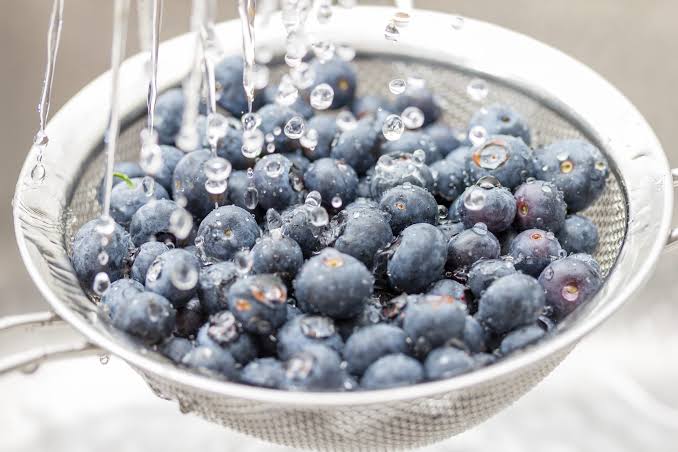Blueberry mold is a type of fungus that can grow on blueberries if they are not stored properly. Mold is a tiny living thing that likes to grow in warm and damp places. When it finds a good home on blueberries, it makes them look fuzzy and not good to eat.
Imagine a tiny invisible world where mold spores float in the air. These spores are like little seeds looking for a cozy spot to settle down. When they land on blueberries, especially if they are wet, they start to grow into mold. This mold can be different colors, but on blueberries, it’s often white or green.
If you see blueberries covered in mold, it’s important not to eat them. Mold can make you sick. The mold sends out tiny threads that you can’t see, and these threads can spread and make more mold. So, it’s best to keep mold away from your blueberries.
To prevent blueberry mold, store them in a cool and dry place. Don’t leave them in a warm and humid area, as this is like a perfect home for mold. Also, make sure to check your blueberries regularly. If you spot any mold, remove those berries and throw them away.
Blueberry mold is like a little unwanted visitor that can spoil the tasty berries. By keeping blueberries dry and cool, you can help prevent mold from making its home on these delicious fruits. Remember, it’s always better to enjoy fresh and mold-free blueberries for a tasty and healthy treat!
When blueberry mold takes hold, it’s not just about the visible fuzziness; there’s more happening at a microscopic level. Mold can release tiny substances called mycotoxins. These mycotoxins are like little chemicals that mold uses to defend itself. Unfortunately, they can be harmful to humans if consumed in large amounts.
So, not only does the mold make the blueberries look unappetizing, but it also adds this extra layer of potential harm. That’s why it’s crucial to be mindful of the condition of the berries you consume.
Interestingly, mold isn’t always a bad thing. In fact, some molds are used to make certain types of cheese, like blue cheese. However, the molds used in cheese-making are controlled and carefully monitored to ensure they don’t produce harmful substances.
When it comes to blueberries, the goal is to keep them fresh and free from unwanted mold. If you happen to buy more blueberries than you can eat right away, consider freezing them. Freezing is like pressing pause on the growth of mold. Just make sure to wash and dry the berries thoroughly before freezing to eliminate any potential mold spores.
In essence, the story of blueberry mold is a cautionary tale about the delicate balance between freshness and spoilage. By understanding the conditions that mold loves and taking simple steps to keep blueberries in the right environment, we can enjoy these little bursts of sweetness without any unwelcome surprises. Remember, a little care goes a long way in keeping your blueberries mold-free and delightful!
Read Also: Balloon Flowers (Platycodon grandiflorus): All You Need to Know About
Causes of Blueberry Mold

The causes of blueberry mold can be traced back to a combination of factors, primarily revolving around environmental conditions and handling practices. Let’s explore these causes in simple terms:
1. Moisture: Mold loves dampness. If blueberries get wet and stay wet, it creates a perfect environment for mold to grow. This could happen during washing or if they’re stored in a humid place.
2. Warmth: Mold thrives in warm temperatures. If blueberries are stored in a warm area, it encourages the rapid growth of mold. Keeping them cool is like giving mold a less favorable habitat.
3. Airborne Spores: Mold doesn’t just appear out of nowhere; it comes from tiny spores in the air. If these spores land on moist blueberries, they can start growing, leading to the visible mold.
4. Poor Storage: If blueberries are stored in a way that traps moisture, like in a sealed plastic bag, it can create a microenvironment perfect for mold. Proper ventilation is key to preventing mold growth.
5. Overripe Berries: Blueberries that are past their prime are more susceptible to mold. As they age, they become softer and provide an easier surface for mold to latch onto.
Understanding these causes empowers us to take simple steps to keep our blueberries fresh. By keeping them dry, cool, and well-ventilated, we create an environment that’s less inviting to mold. Additionally, promptly using or freezing ripe blueberries can prevent them from reaching a state where mold is more likely to take hold.
Read Also: Balsam Flowers – All You Need to Know About
How to Prevent Blueberry Mold

Preventing blueberry mold is quite manageable with a few straightforward steps. Here’s a guide on how to keep those blueberries mold-free:
1. Inspect Before Purchase: When buying blueberries, check for any signs of mold at the store. Avoid containers with squished or damaged berries, as these are more prone to mold.
2. Store in the Fridge: Blueberries like the cool company. After bringing them home, store them in the refrigerator to slow down the growth of mold. A cool environment helps keep them fresh for a more extended period.
3. Dry Thoroughly: Before storing blueberries in the fridge, make sure they are completely dry. Moisture promotes mold growth, so a good rinse followed by thorough drying can be your first line of defense.
4. Use or Freeze Promptly: Freshness matters. Try to use your blueberries as soon as possible after purchasing. If you can’t finish them in time, freeze them. Freezing halts the growth of mold, preserving the berries for later use.
5. Avoid Moisture Traps: Don’t store blueberries in sealed plastic bags or containers without ventilation. Opt for containers with holes or use a breathable cloth to cover them. This helps prevent the accumulation of moisture.
6. Inspect Regularly: Keep an eye on your blueberries. Regularly inspect them for any signs of mold. If you spot any, remove those affected berries immediately to prevent the mold from spreading.
7. Separate Overripe Berries: If you have a mix of ripe and overripe blueberries, separate them. Overripe berries are more susceptible to mold, and keeping them away from the fresher ones can help maintain the overall freshness.
8. Gentle Handling: Treat your blueberries with care. Rough handling can cause bruising and damage, creating openings for mold to take hold. Be gentle when washing and transferring them to avoid unnecessary harm.
9. Proper Ventilation: Allow air to circulate around your blueberries. Ventilation is crucial in preventing the buildup of moisture. Instead of sealing them tightly, opt for containers with holes or use breathable bags.
10. Check the Environment: Be mindful of where you store your blueberries. Keep them away from areas with high humidity, such as near the stove or dishwasher. Choose a cool, dry spot in the fridge to extend their freshness.
11. Educate Others: Share these simple tips with friends and family. The more people know about proper blueberry care, the less likely they are to encounter moldy surprises. It’s a collective effort to enjoy fresh and tasty berries.
12. Rotate Stock: If you buy blueberries regularly, practice the “first in, first out” principle. Consume the older berries before the newer ones. This ensures that none of them linger in storage for too long, reducing the chances of mold growth.
13. Consider Refrigerated Transport: If you’re transporting blueberries, especially in warmer weather, consider using a cooler or insulated bag. Keeping them cool during transit helps maintain their freshness.
In essence, preventing blueberry mold is about creating a favorable environment for your berries while being mindful of their delicate nature. These simple practices, when consistently applied, contribute to a delightful blueberry experience, free from the interference of unwelcome mold.
Incorporating these simple practices into your blueberry care routine, you’ll significantly reduce the risk of encountering that unwanted fuzzy mold. Remember, a little attention goes a long way in preserving the deliciousness of your blueberries!
Read Also: Advantages of Waste Recycling

